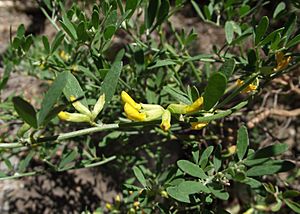Acmispon dendroideus facts for kids
Quick facts for kids Acmispon dendroideus |
|
|---|---|
 |
|
| Scientific classification | |
| Synonyms | |
|
Species:
Varieties: See text. |
Acmispon dendroideus, often called the island broom, is a special plant. It is a type of legume, like peas or beans. This plant grows only in California. You can find it on the Channel Islands of California. It likes to grow on coastal cliffs and bluffs.
The island broom can be a spreading plant or a tall shrub. It can grow up to 2 meters (about 6.5 feet) high. Its color is usually gray-green. The plant can be smooth or a bit hairy. Its branches have small, oval leaves. Each leaf is about 1.5 centimeters long. The plant produces groups of up to 10 yellow, pea-like flowers. Each flower is about a centimeter long. They turn red as they get older.
Special Varieties of Island Broom
There are different types, or varieties, of the island broom plant. One of these is very rare.
San Clemente Island Broom
The rarest variety is called Acmispon dendroideus var. traskiae. It is also known as the San Clemente Island broom or San Clemente Island lotus. This variety only grows on San Clemente Island.
This special plant is listed as an endangered species. This means it is at high risk of disappearing forever.
Helping the San Clemente Island Broom
In the 1990s, the U.S. Navy helped this plant. They removed goats from San Clemente Island. Goats were eating the plants and stopping them from growing. The Navy also started a special program to protect the plant.
Because of these efforts, the San Clemente Island broom is doing much better. It has grown from only 9 groups of plants to over 150 groups. Now, there are more than 10,000 individual plants. In 2007, experts suggested that its status could be changed. They thought it could be moved from "endangered" to "threatened." This shows how much the plant has recovered.

